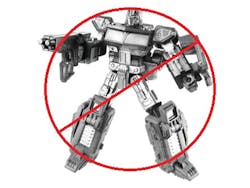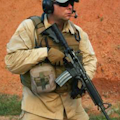Check your Fire! Operating in a 360 Degree World
This month we are going to talk about friendly fire and negligent shootings. Before you throw out the “Monday Morning Quarterback” analogy, stop for a moment. The FAA doesn’t investigate airplane crashes out of spite. They investigate so as to discover the reason behind the crash and to try and figure out a way to prevent future crashes.
When we have a “crash” in the LE community it’s up to us to examine that crash and try to determine whether or not the incident was preventable or inevitable. Yes, we are referring to the NYPD shooting last month near the Empire State Building. Get butt-hurt all you want. We can’t simply say “Sh*t happens” and move on.
The Dilemma
First and foremost we will accept that a life or death gunfight the most dynamic and dangerous situation in which a law enforcement officer can be involved, high speed pursuits being a close second. Unlike the square range where we all train, in the real world the targets often refuse to stand still, mingle among “no shoot” objects, and behave in an unpredictable fashion.
Let’s take a look at how we “train” officers to deal with the above situation. After they have graduated from the Academy, we put officers through an annual or semi-annual “Qualification” course. (If your agency is forward thinking and goes far and beyond the basics you are dismissed, go get some coffee or a Red Bull for you rookies.)
By the time they have six months on the job most officers have the Qual Course memorized. The course of fire is anything but unpredictable. By mandate, the targets are always the same shape and size and placed and predetermined distances. Officers are taught to fire a very specific number of rounds in a specific order. Failure to do so will result in disqualification.
When I was on the job I could recite the state qualification course in my sleep. By design, the Qual Course is supposed to be a “minimum” standard, not the maximum. Unfortunately, far too many agencies use the Qual Course to fulfill the state mandated annual training requirements. When questioned about officer training many police administrators are taught to respond that “all officers involved in the shooting incident qualified on the state course”. Using a State Qualification as “training” is like using a driver’s license test to prepare for the next NASCAR race.
Training for Reality?
How do we train officers to deal with the hyper-violent and unpredictable situation of a deadly force encounter? I find it ridiculous that officers, who are allowed to carry a gun amongst the public day in and day out, are often treated like children when it is time for firearms training. I was recently at an LE training range that required all officers arriving for firearms training to unload and clear their weapons before entering the range. Not the “Sims” house or DT classroom, the live fire shooting range. All officers had to fiddle with their weapons at the entry gate, a recipe for an ND.
The “firing line” is another artificial invention of the square range. Officers are taught to stand on a certain firing line. We even go so far as to paint them on the ground or use ropes and string. Time and money are wasted painting signs with numbers so everyone knows they are exactly 21 feet from the target, etc. When’s the last time you saw a firing line on the street? Are you allowed to engage a felon with a gun if he is 12.7 yards away? Have you ever fired your gun from 12.7 yards?
When it comes time for live-fire, are your officers allowed to fire an additional round or two if they feel like their first ones were off the mark? Is every drill 2 shots and back to the holster? Do your officers have to think and make a decision before they fire their guns or do you make all the decisions for them? Do you people fire on the exact same target at the exact same distance? Depending on the answers to the above questions you may not be training your people for reality, but instead creating shooting robots.
No Shooting Robots
We all know the definition of insanity: doing the same thing over and over while expecting a different result. When we talk about LE firearms training, we often fall into that category. We do it the same way over and over and act surprised when we don’t get the end results we desire. When you live and die by the qualification course all you are doing is creating robots that shoot.
The answer isn’t magic bullets or heavier triggers. The answer is better training and more of it. If you have officers who can barely pass the state qualification course you might consider finding them a job that doesn’t require a gun.
Finally, don’t tell me it can’t be done. I just re-watched a helicopter video of a Huntington Beach (CA) PD shooting. A crazed felon with a knife is running around trying to stab officers. The felon, surrounded 360 degrees by officers on a public street, was successfully put down with gunfire. No officers or innocents were struck. Huntington Beach PD has a very forward thinking and active firearms training program.
Again, the choice is yours. Keep doing things the way you always have or put a greater emphasis on improving training and preparing officers for the dangers they face each day.
Web Links:
About The Author:
Mr. Markel is a former United States Marine, Police Officer, and has worked as a professional bodyguard both in the U.S. and overseas. A Subject Matter Expert on Small Arms and Tactics, Markel has provided instruction to law enforcement and U.S. Military troops.
As a recognized author and writer, Paul has penned several hundred articles published in numerous professional journals and trade periodicals. Topics include firearms training, use of force, marksmanship, less-than-lethal force options, product reviews and evaluations, emergency medical care, and much more. Sought after as a public speaker, Mr. Markel is at home in front of an audience large or small.
About the Author
Paul Markel
Mr. Markel is a former United States Marine, Police Officer, and has worked as a professional bodyguard both in the U.S. and overseas. A Subject Matter Expert on Small Arms and Tactics, Markel has provided instruction to law enforcement and U.S. Military troops.
As a recognized author and writer, Paul has penned several hundred articles published in numerous professional journals and trade periodicals. Topics include firearms training, use of force, marksmanship, less-than-lethal force options, product reviews and evaluations, emergency medical care, and much more. Sought after as a public speaker, Mr. Markel is at home in front of an audience large or small.
Follow Mr. Markel's instructional show: http://www.studentofthegun.com

